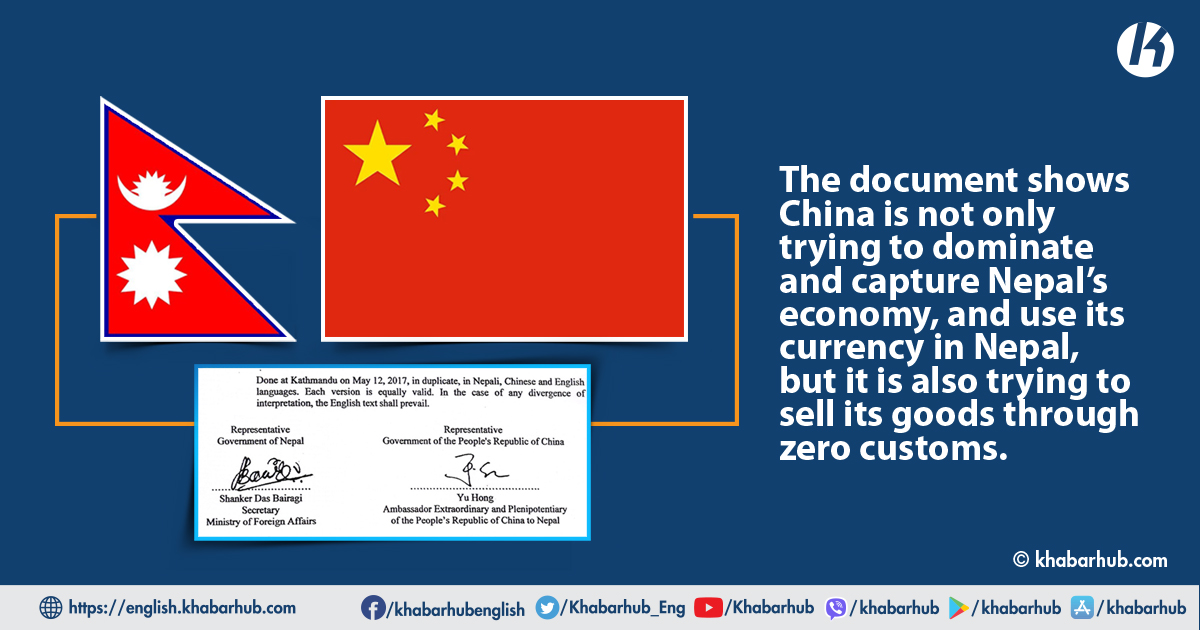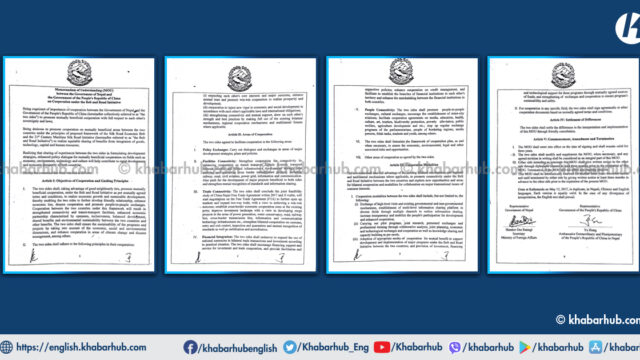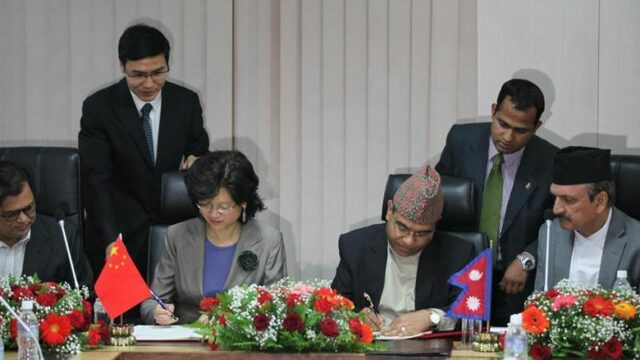0%

KATHMANDU: China, through its Belt and Road Initiative (BRI) agreement, has attempted to impose its economic hegemony, conditions, and vested interest in Nepal in the name of Free Trade Connectivity, the Memorandum of Understanding (MoU) obtained by Khabarhub has revealed.
Clause III of Article II of the MoU mentions Trade Connectivity saying that the two sides shall conclude the joint feasibility study of the China-Nepal Free Trade Agreement within 2017 and if viable, and will start negotiations on the Free Trade Agreement (FTA) to further open up markets and expand two-way trade, with a view to achieving a win-win situation.
The document signed by both Nepal and China on BRI is a clear gesture on the part of China that it is not only trying to dominate and capture Nepal’s economy, and to use its currency in Nepal, but it is also trying to sell its goods through zero customs.
In the MoU signed by the then Shanker Das Bairagi, Secretary at Nepal’s Ministry of Foreign Affairs (MoFA) and then Chinese Ambassador to Nepal Yo Hong in May 2017, China’s endeavor to impose its monopoly in Nepal in the name of “promoting cooperation on mutually beneficial areas” under the principles of BRI, looks evident.
However, neither the Government of Nepal nor China made the document public despite being signed five years ago.
Here, in this case, political analyst Saroj Mishra has serious doubts that Nepal could be under immense pressure from China to not make the document public.
“Until and unless it is a very sensitive and security-related document, every Nepali citizen has the right to exercise the right to information,” Mishra said, adding, “If so, why is the government reluctant to provide the information?”
He also raised concerns about what is barring the government from making it public.
And more enigmatically, China, in the MoU, has imposed its clause saying that both the sides would “strengthen cooperation for connectivity by enhancing cooperation on transit transport, logistic systems, transport network security and related infrastructures development through joint studying and promoting cross border infrastructure projects, including railway, road, civil aviation, power grid, information, and communication.”
According to the document, the MoU shall be automatically renewed for another three years thereafter unless and until terminated by either side by giving written notice at least three months in advance to the other side prior to the expiration of the present MoU.
Even though while signing the MoU in 2017, it was stated that the MoU shall enter into effect on the date of signing and shall remain valid for three years. However, not a single project has taken off.
“This is a traditional and conversationalist approach on the part of Nepal and China for not making public the BRI document,” says Taranath Dahal, a senior journalist and Chairman of Freedom Forum, an anti-corruption non-government organization.
“Since there is no transparency, the question of accountability pops up,” he told Khabarhub.
The document shows China is not only trying to dominate and establish its hegemony in Nepal’s economy, and use its currency in Nepal, but it is also trying to sell its goods through zero customs.
According to the MoU, the two sides shall modify and supplement the MOU, when necessary, and any agreed revision in writing shall be considered an integral part of this MOU.
The MoU also mentions that either side intending to terminate this MOU shall give written notice to the other side through a diplomatic channel at least three months prior to the expiration of this MOU.
It should be noted that in a joint statement issued from Beijing, the two sides had agreed to expedite the implementation of the MoU on cooperation under the BRI to enhance connectivity within the overall framework of cross-border Himalayan multidimensional connectivity.
However, Dr. Jagdish Chandra Pokhrel, former Vice Chairman of Nepal Planning Commission, had earlier said that the issue of China’s railways and oil is under constant doubt as it is not yet clear which model China will invest in the mentioned projects and infrastructure and what will be Nepal’s ownership and contribution in those infrastructures.
Sources have claimed that Nepal has claimed that there should be competitive bidding in BRI projects and that the bidding should be open to all, not only the Chinese firms.
Article I of the MoU in its Objectives of Cooperation and Guiding Principles states: “The two sides shall, taking advantage of good neighborly ties, promote mutually beneficial cooperation, under the Belt and Road Initiative as per mutually agreed terms and conditions, to realize economic growth and sustainable development; thereby enabling the two sides to further develop a friendly relationship, enhance economic ties, deepen cooperation and promote people-to-people exchanges.”

It further says, “Cooperation between the two countries under this framework will result in strengthened connectivity and transit-transport facilities, enhanced economic partnership characterized by openness, inclusiveness, balanced development, shared benefits and environmental sustainability between the two countries and other benefits.”
According to the MoU, the two sides shall ensure the sustainability of the programs and projects by taking into account the economic, social and environmental dimensions, and enhance cooperation in areas of climate change and disaster management, among others.”
Likewise, Clause II of Article 1 says that the two sides shall adhere to the principles in their cooperation by “respecting each other’s core interests and major concerns, enhance mutual trust and promote win-win cooperation to realize prosperity and development; and cooperate to inject new vigor in economic and social development in accordance with each other’s applicable laws and international obligations.”
Here, Vinay Yadav, Chairman of the Rastriya Ekata Abhiyan, says, “Some of the provisions of the BRI are an attempt to bring Nepal’s economy under Chinese control.”
Yadav said that it was treasonous to enter into an agreement under BRI so that Nepali goods could be procured in Chinese currency.
Moreover, the MoU mentions developing information and communication technology infrastructures, etc., strengthening bilateral cooperation on customs, entry and exit control, inspection and quarantine and mutual recognition of standards as well as certification and accreditation.
The idea of creating a free trade zone between Nepal and China under the same agreement is even more dangerous, he claimed.
“Under the concept of free trade, customs duty on import and export has been brought down to almost zero,” he said adding that at a time when Nepal’s trade deficit is at an all-time low, such tariffs will be reduced to zero, making Nepal completely dependent on China for imports.
“The two sides will work toward strengthening connectivity and mutual support, draw on each other’s strength and best practices by making full use of the existing bilateral mechanisms, regional cooperation mechanisms and multilateral forums where applicable,” Article II of the MoU states.
Article II also talks about the areas of cooperation in which the two sides have agreed to facilitate cooperation in Policy Exchanges to carry out dialogues and exchanges in areas of major development strategies, plans and policies.
It also mentions Facilities Connectivity to strengthen cooperation for connectivity by enhancing cooperation on transit transport, logistic systems, transport network security and related infrastructures development through joint studying and promoting cross-border infrastructure projects, including railway, road, civil aviation, power grid, information and communication.
Nepal and China have also agreed to push for the development of major projects beneficial to both sides and strengthen mutual recognition of standards and information sharing.
The MoU, in clause III of Article II mentions Trade Connectivity saying that the two sides shall conclude the joint feasibility study of the China-Nepal Free Trade Agreement within 2017 and if viable, and will start negotiations on the Free Trade Agreement (FTA) to further open up markets and expand two-way trade, with a view to achieving a win-win situation.
They have also talked about establishing a cross-border economic cooperation zone at the existing ports; improve the investment landscape with a view to developing mega projects in the areas of power generation, water conservancy, road, railway line, and cross-border transmission lines.
However, Khabarhub has repeatedly published stories of how China has imposed an undeclared blockade on Tatopani and Rasuwagadhi checkpoints by not allowing Nepali goods to enter Nepal despite repeated concerns from the Nepali side, especially the traders.
However, former Ambassador to Denmark and analyst, Vijay Kant Karna says, “BRI is not transparent because both the governments — Nepal and China — didn’t make it public.”
He blames Nepal’s left political parties for creating a myth that China can do no harm and there was no need to read any documents that are signed between the two countries.
They (The left parties) have set a notion that China is Nepal’s friend and will not harm Nepal’s interests.
According to him, Nepal’s left parties are biased against India and US, and in favor of China.
Moreover, the MoU mentions developing information and communication technology infrastructures, etc., strengthening bilateral cooperation on customs, entry and exit control, inspection and quarantine and mutual recognition of standards as well as certification and accreditation.
Meanwhile, the MoU also talks about Financial Integration in which the two sides shall endeavor to expand the use of national currencies in bilateral trade transactions and investment according to practical situations.
“The two sides shall encourage financing support and service for investment and trade cooperation, and provide facilitation and supportive policies; enhance cooperation on credit management, and facilitate to establish the branches of financial institutions in each other’s territory and enhance the matchmaking between the financial institutions in both countries,” Clause IV of Article II of the MoU states.
In terms of People Connectivity, the MoU mentions that the two sides shall promote people-to-people exchanges, and cultural exchanges, encourage the establishment of sister-city relations; and facilitate cooperation agreements on media, education, health, culture, and art, tourism, and biodiversity protection.
“Cooperation modalities between the two sides shall include, but are not limited to exchange of high-level visits and existing governmental and non-governmental mechanisms, the establishment of multi-level information sharing platform in diverse fields through multiple channels to realize information sharing, increase transparency and mobilize the people’s participation for development and enhanced cooperation.”
Meanwhile, journalist Krishna Timilsina, who is also a regular contributor to Khabarhub, says that the Chinese authorities had (during his China visit) told him that any country joining BRI would see unprecedented development.
“After seeing the infrastructure development in different cities of China, I had wondered whether the same would be implemented in Nepal too,” he said.
“After returning to Nepal, it was natural to wonder what kind of agreement was made with China that would bring transformational development to Nepal,” Timilsina said.
He further added, “And as I went to the Ministry of Foreign Affairs and even the Chinese Embassy, I could not get any document that ensured such a development. No one provided me with the document since it was “confidential”. I tried to get the documents referring to CRI and CGTN.”
“As I saw the 55-meter long bridge connecting Hong Kong-Zhuhai-Macau, and after I came back, I was shocked by the loan terms of Pokhara Airport and the failure of BRI in Pakistan and Sri Lanka,” he added.
Meanwhile, poverty alleviation, public welfare, agriculture development and etc. stepping up regular exchange programs of the parliamentarians, people of bordering regions, media persons, think tanks, students and youth, among others are also some of the points included in Clause V Article II.
According to the MoU, the two sides shall formulate the framework of a cooperation plan, as and when necessary, to assess the economic, environmental, legal and other associated risks and opportunities.

Article III of the MoU talks about Cooperation Modalities in which Nepal and China shall take full advantage of the existing bilateral mechanisms, and regional and multilateral mechanisms where applicable, to promote connectivity under the Belt and Road Initiative between the two countries and explore new opportunities and areas for bilateral cooperation and modalities for collaboration on major transnational issues of common interests.
“Cooperation modalities between the two sides shall include, but are not limited to exchange of high-level visits and existing governmental and non-governmental mechanisms, the establishment of multi-level information sharing platform in diverse fields through multiple channels to realize information sharing, increase transparency and mobilize the people’s participation for development and enhanced cooperation.”
However, political analyst Devesh Jha says despite repeated attempts to acquire the BRI-related documents the Government of Nepal did not make the document public.
“It has become a mystery that the government is not interested to address the concerns of the Nepali people as it is well aware of the severe economic crisis faced by Pakistan and Sri Lanka, which are members of BRI,” he said adding, “Perhaps the provisions of this agreement are not in the national interest.”
If the discussions are to be considered, the interest rate of BRI is 4% and the repayment period is only 10 years instead of the average of 25-30 years as compared to international loans which can be easily obtained at an interest rate of one to one and a half percent, according to Jha.
“It is clear that Nepal could also fall into the debt trap as Sri Lanka for not being able to repay the BRI loan. This could be one of the reasons why the BRI document has not been made public,” he added.
Likewise, Article III mentions carrying out pilot programs, joint research, personnel exchanges, and professional training through collaborative analysis, joint planning, economic and technological exchanges and cooperation as well as knowledge sharing, and capacity building as per the needs.
Likewise, the adoption of appropriate modes of cooperation for mutual benefit to support the development and implementation of major programs under the BRI between the two countries is also mentioned in the MoU.
According to the understanding, for cooperation in any specific field, the two sides shall sign agreements or other cooperation documents based on mutually agreed terms and conditions.
Meanwhile, Article IV mentions the Settlement of Differences in which the two countries shall settle the differences in the interpretation and implementation of this MOU through friendly consultation.
As per Article V which talks about Commencement, Amendment and Termination, the “MOU shall enter into effect on the date of signing and shall remain valid for three years.”
“The two sides shall modify and supplement the MOU, when necessary, and any agreed revision in writing shall be considered as an integral part of this MOU.”
Either side intending to terminate the MoU shall give written notice to the other side through a diplomatic channel at least three months prior to the expiration of the MoU.
“Termination of the MOU will not affect any ongoing projects,” it mentions.
According to the document, the MoU shall be automatically renewed for another three years thereafter unless and until terminated by either side by giving written notice at least three months in advance to the other side prior to the expiration of the present MoU.
After Nepal signed the BRI agreement, Chinese President Xi Jinping paid a state visit to Nepal in October 2019.
During the visit, China urgently raised the issue of the implementation of the BRI agreement.
However, even Xi, who declared Nepal a land-linked country from a landlocked country, did not reveal anything about the Chinese investment model.
In a joint statement issued by the two countries, it was mentioned that a feasibility study of the Kathmandu-Kerung railway has been agreed upon.
Meanwhile, economist Achyut Wagle states there has been no progress in the BRI projects so far after it was signed in 2017.
Moreover, he argues since there has been a lack of political consensus on the issue, it could be one of the reasons why the document has not been made public.
BRI: 5 agreements in 5 years; all documents confidential
China’s Policy: To occupy Nepal’s major projects and keep them in limbo
Dozens of Chinese contractors blacklisted; scams unbridled
How long will China’s undeclared blockade on Nepal continue?
China’s BRI in Nepal burdened with hollow promises as Rasuwagadhi border remains closed
China eyeing Nepali media spectrum through illegal investment, local media reports
Is Nepal becoming a haven for Chinese criminals?
With promises to marry, Nepali girls trafficked to China
Chinese contractor company flouting law; operating vehicles sans number plates (with video)
Fast Track: PAC smells rat while awarding contract to Chinese company
China’s announcement of making Nepal a ‘land-linked’ country limited to papers
NA pushes fast-track project ahead by disregarding parliamentary panel’s directive
NA awarding Rs 45 billion contract to Chinese companies “surreptitiously” amid political crisis
China’s persistent pressure on Nepal
NAC’s Chinese planes too costly; incur loss of Rs 5 billion
Purchase of Chinese aircraft: Throwing money down the drain
Nepal facing alarming Chinese pressure of late
China pressurizes Nepal to accept Sinopharm’s vaccine instantly
China ramps up intimidation of border findings, sends letter undiplomatically (With full text)
From Mt Everest to Humla; China’s hostility continues in Nepal
Chinese nationals’ involvement in crimes increasing in Nepal
A revelation of Nepal-China agreement: Nepal gets tougher on Tibetans